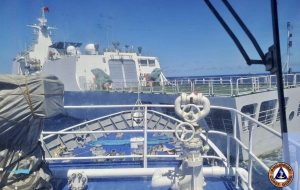The Philippine military has accused China’s coast guard of blocking and shooting a water cannon at a Philippine military supply boat in the South China Sea, condemning the actions as “excessive and offensive.”
The “dangerous maneuvers,” which were aimed at preventing a Philippine boat from resupplying forces stationed at Second Thomas Shoal, were undertaken “in wanton disregard of the safety of the people on board and in violation of international law,” the Armed Forces of the Philippines said in a statement yesterday.
The military called on the Chinese coast guard and China’s central military commission “to act with prudence and be responsible in their actions to prevent miscalculations and accidents that will endanger people’s lives.”
According to The Associated Press, Philippine navy personnel on board two chartered supply boats were cruising toward the shoal on Saturday, escorted by Philippine navy vessels, when “a Chinese coast guard ship approached and used a powerful water cannon to block the Filipinos from the shoal.”
The boats were attempting to bring supplies including food, water, and fuel, to the detachment of marines living aboard the BRP Sierra Madre, a rusting World War II-era ship that was intentionally grounded on the shallow waters of the shoal in 1999. Ayungin Shoal, as Manila refers to it, lies within the Philippines’ Exclusive Economic Zone (EEZ), but is claimed by Beijing under its maximalist “nine-dash line” maritime claim.
In a statement yesterday, Commodore Jay Tarriela, the spokesperson of the Philippine Coast Guard (PCG) for the West Philippine Sea, called on China’s coast guard “to restrain its forces, respect the sovereign rights of the Philippines in its [EEZ] and continental shelf, refrain from hampering freedom of navigation, and take appropriate actions against the individuals involved in this unlawful incident.”
This is not the first time that Chinese vessels have attempted to prevent the resupply of Second Thomas Shoal, nor the first time that they have used water cannons to do so. In November 2021, ships blocked and fired water cannons at two Filipino vessels carrying food and other supplies to the shoal. In February of this year, the PCG accused a Chinese coast guard ship of hitting a Philippine coast guard vessel with a military-grade laser during an encounter close to Second Thomas Shoal, temporarily blinding some of the crew.
The incident is just the latest in a series of aggressive Chinese actions designed to loosen the Philippines’ hold over its features in the South China Sea. Collin Koh, a senior fellow at the S. Rajaratnam School of International Studies in Singapore, argued that the “recent series of PRC actions around the Second Thomas Shoal appears aimed at isolating the military outpost, gradually eroding Manila’s ability to sustain it and eventually compel the withdrawal of [the Philippines’] physical presence at the feature.” Crucially, water cannons and lasers are classic “gray zone” tactics, in that they are effective in driving away Philippine vessels, yet fall beneath the threshold of actions that would require a military response, either by the Philippines or by its American ally.
If Beijing is seeking to force Manila to back down and relinquish its claims over these features, however, the strategy does not appear to be working. Tensions in the South China Sea have been one of the primary drivers of the rapid reinforcement of the U.S.-Philippine security alliance by President Ferdinand Marcos Jr. since he took office in June of last year. Among other things, this has involved the expansion of the U.S. military’s access to Philippine military facilities, including a second base on the western island of Palawan, in close proximity to the South China Sea.
Shortly after the incident, the U.S. State Department said that Washington stood with its Philippine allies in the face of such “dangerous actions.”
“Such actions by the PRC are inconsistent with international law and are the latest in repeated threats to the status quo in the South China Sea, directly threatening regional peace and stability,” it stated. It also reaffirmed that any armed attack on Philippine public vessels, aircraft, and armed forces, including those of its Coast Guard in the South China Sea, would “invoke U.S. mutual defense commitments under Article IV of the 1951 U.S. Philippines Mutual Defense Treaty.”

































